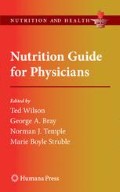Key Points
-
A lifestyle based on a healthy diet and regular physical activity delays the appearance of age-related changes and slows the development of chronic disease, morbidity, and disability.
-
Age-related changes in nutrient requirements follow no general pattern but increase, decrease, or remain unchanged depending on the nutrient; at the same time energy needs continue to decline underscoring the importance of foods high in nutrient density.
-
Both inappropriate weight gain and debilitating weight loss increase the risk of chronic disease and disability; loss of muscle leading to frailty and dependence can be prevented or reversed with strength training.
-
Nutrient supplements may be needed as energy intake declines but recommendations should take into consideration individual needs, current medications, and food intake to prevent toxicity or dangerous interactions.
-
Community nutrition programs providing congregate or home-delivered meals can help older individuals maintain appropriate intakes of important nutrients when loneliness, anorexia, limited resources, or disability make it difficult to obtain or prepare adequate and appropriate food.
Access this chapter
Tax calculation will be finalised at checkout
Purchases are for personal use only
Suggested Further Reading
Centers for Disease Control and Prevention and the Merck Company Foundation. The State of Aging and Health in America 2007. Merck Company Foundation, Whitehouse Station, NJ, 2007. Available from http://www.cdc.gov/aging
Evans WJ. Protein nutrition, exercise and aging. J Am Coll Nutr 2004; 23(suppl):601S–609S.
Holick MF. Vitamin D deficiency. N Engl J Med 2007; 357:266–281.
Lichtenstein AH, Russell RM. Essential nutrients: Food or supplements? JAMA 2005; 294:351–358.
Thomas DR. Loss of skeletal muscle mass in aging: Examining the relationship of starvation, sarcopenia and cachexia. Clin Nutr 2007; 26:389–399.
References
Centers for Disease Control and Prevention and the Merck Company Foundation. The State of Aging and Health in America 2007. The Merck Company Foundation, Whitehouse Station, NJ, 2007. Available from http://www.cdc.gov/aging. Accessed April 17, 2008.
Fiatarone MA, O’Neill EF, Ryan ND, et al. Exercise training and nutritional supplementation for physical frailty in very elderly people. N Engl J Med 1994; 330:1769–1775.
Russell RM. Factors in aging that effect the bioavailability of nutrients. J Nutr 2001; 131(suppl): 1359S–1361S.
Lichtenstein AH, Rasmussen H, Yu WW, et al. Modified MyPyramid for older adults. J Nutr 2008; 138:5–11.
United States Department of Agriculture. MyPyramid Food Intake Pattern Calorie Levels. Center for Nutrition Policy and Promotion, Washington, DC, April 2005. Available from http://www.MyPyramid.gov. Accessed April 17, 2008.
Institute of Medicine. Dietary reference intakes. The Essential Guide to Nutrient Requirements. National Academies Press, Washington, DC, 2006.
Campbell WW, Carnell NS, Thalacker AE. Protein metabolism and requirements. In: Chernoff R, ed. Geriatric Nutrition: The Health Professional’s Handbook, 3rd ed. Jones & Bartlett, Sudbury, MA, 2006, pp. 15–22.
Miller ER III, Pastor-Barriuso R, Dalal D, et al. Meta-analysis: high-dosage vitamin E supplementation may increase all-cause mortality. Ann Intern Med 2005; 142:37–46.
Feskanich D, Weber P, Willett WC, et al. Vitamin K intake and hip fractures in women: A prospective study. Am J Clin Nutr 1999; 69:74–79.
Holick MF. Vitamin D deficiency. N Engl J Med 2007; 357:266–281.
Champagne CM. Dietary interventions on blood pressure. The Dietary Approaches to Stop Hypertension (DASH) trials. Nutr Rev 2006; 64(part 2): S53–56.
American Dietetic Association. Position of the American Dietetic Association: Fortification and nutritional supplements. J Am Diet Assoc 2005; 105:1300–1311.
Roberts SB. A review of age-related changes in energy regulation and suggested mechanisms. Mech Ageing Dev 2000; 116:157–167.
Thomas DR. Loss of skeletal muscle mass in aging: Examining the relationship of starvation, sarcopenia and cachexia. Clin Nutr 2007; 26:389–399.
Adams KF, Schatzkin A, Harris TB, et al. Overweight, obesity, and mortality in a large prospective cohort of persons 50–71 years old. N Engl J Med 2006; 355:763–778.
Al Snih S, Ottenbacher KJ, Markides KS, et al. The effect of obesity on disability vs. mortality in older Americans. Arch Intern Med 2007; 167:774–780.
Author information
Authors and Affiliations
Editor information
Editors and Affiliations
Rights and permissions
Copyright information
© 2010 Humana Press, a part of Springer Science+Business Media, LLC
About this chapter
Cite this chapter
Schlenker, E.D. (2010). Healthy Aging: Nutrition Concepts for Older Adults. In: Wilson, T., Bray, G., Temple, N., Struble, M. (eds) Nutrition Guide for Physicians. Nutrition and Health. Humana Press. https://doi.org/10.1007/978-1-60327-431-9_19
Download citation
DOI: https://doi.org/10.1007/978-1-60327-431-9_19
Published:
Publisher Name: Humana Press
Print ISBN: 978-1-60327-430-2
Online ISBN: 978-1-60327-431-9
eBook Packages: MedicineMedicine (R0)

